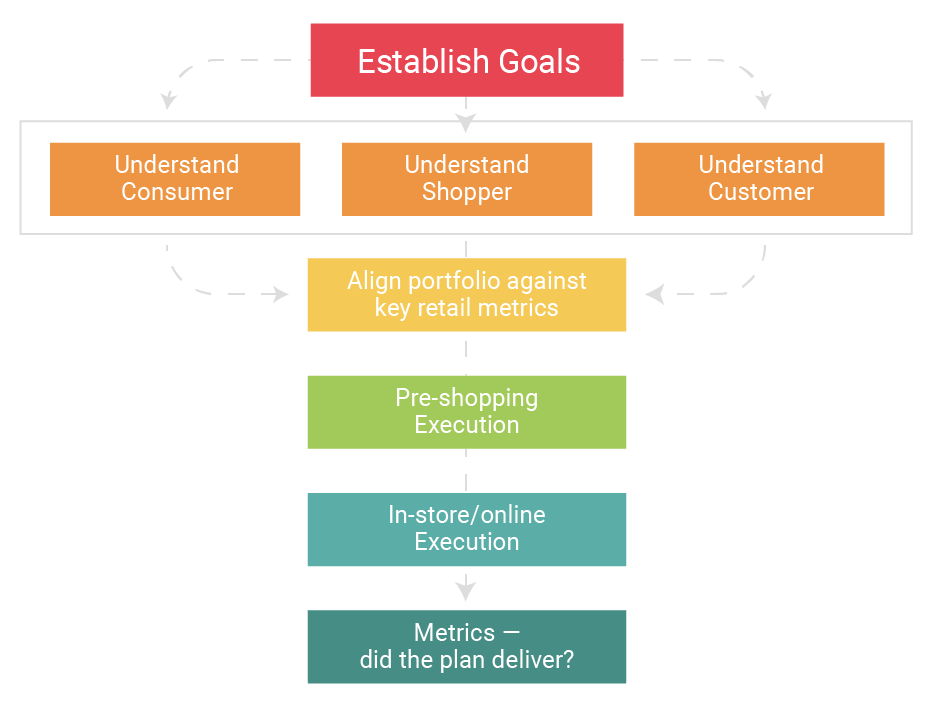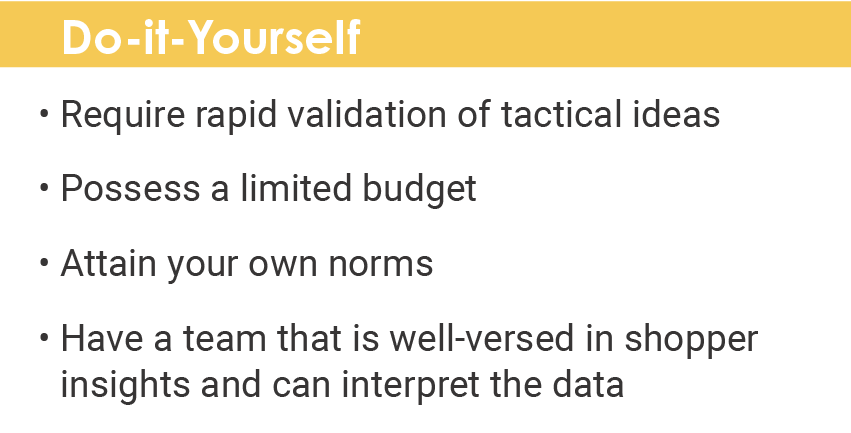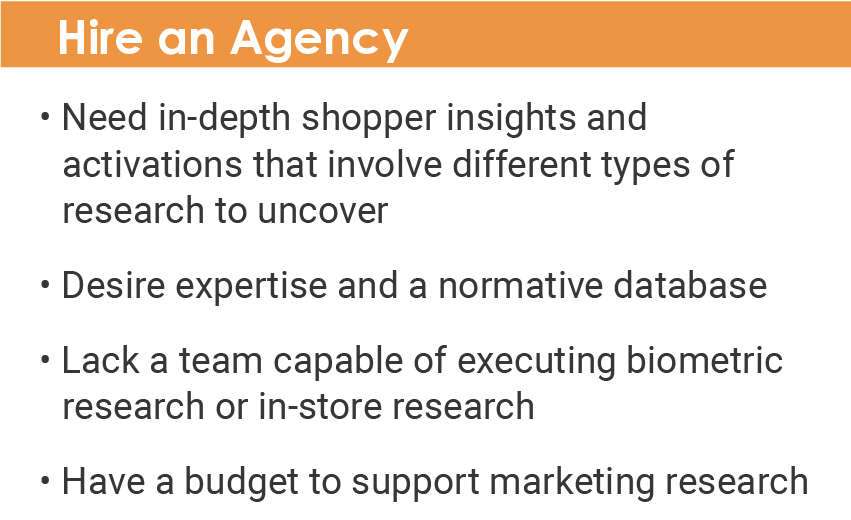Chapter 5:
Who Uses Shopper Marketing Insights? Not Just CPG’s Anymore.

People associate shopper marketing insights with only large retailers and consumer packaged goods (CPG) companies. Retailers, CPG manufacturers, technology, fashion/apparel, automakers, and even B2B companies use shopper insights these days.
Shopper insights are relevant for far more people than just consumer goods manufacturers. Manufacturers tend to focus on increasing their own wallet share through shopper insights. Retailers also use this technique for their own purpose — to increase total spending and improve the profitability of the basket mix. Most retailers will let manufacturers carry out shopper insight efforts on their behalf because they will also have access to the insights to learn how to grow their business.


What happens at the point of sale is crucial for impulse purchasing categories, like gum and cans of soda. The final few seconds of a shopping experience account for a large part of sales. Failing to understand this can cost billions of dollars in lost sales — or if you’re like Coke, who with a simple idea of putting different names on bottles in stores, it can increase sales.
Understanding the shopping process can function for complex purchases as well. Big-ticket auto purchases often involve a research process, crossing many forms of media, and sometimes multiple showroom visits. Obtaining the connection between the dealership and messaging online is crucial. There are B2B transactions that use shopper insights strategically because they understand the world of influencing purchase decision-makers and insights along the Path to Purchase. Shopper insights can deliver a much higher financial reward per transaction, with the same impact in B2B and B2C.
As the Path to Purchase continues to change, every business will need to understand purchasing behavior and how to influence it.

Are Shopper Insights Right for your Organization?
As they used to say, just because you can, doesn’t mean you should. The same applies to shopper insights — many companies use shopper insights, but that doesn’t mean that all companies should.
When there are many competing priorities, it can be hard to decipher if utilizing shopper insights would be effective for your organization.
Three simple questions to ask yourself so you can honestly know if you should invest in understanding shopper insights:
1. How well do you or your team understand your target shoppers?
In some cases, the answer may be very well, but in most cases, the team does not know shoppers as well as they could. Let’s lead with this, just because you yourself shop the category does not mean that you have insights into shoppers’ behavior in general. If you and your team truly understand your target shoppers, you should be able to answer these questions: how do shoppers plan their purchase, on what shopping trips or what needs drive a purchase of your product(s), how do shoppers shop your category, how engaged are your shoppers, and what mindset are they in.
2. What do you want to change about your business?
When you grasp how shoppers think, feel, and behave, you can maintain your market position, but this may not convince the decision-makers that it’s worth investing. Instead, shopper research pays for itself best when used to aid decision-making in business objectives. This can be as basic as understanding why a product line does better in one retailer than in another, or even more complex, how to acquire people to shop for different products in a single shop either online or at retail.
3. Do you understand the overall drivers around your category and brand?
Shopper insights are an excellent way of drilling into the detail of what happens in the retail journey — but
in most cases, they work best in conjunction with consumer insights. Effective shopper insights help identify the triggers and barriers to purchasing. Understanding what will engage your shopper at the point of purchase will drive incremental purchases. Recognizing the triggers can be different throughout each aisle in a store.
Once you determine shopper insights are right for your organization, you need to establish a plan to manage and execute your shopper insights.
Many different approaches are used to implement shopper insights; here is an example for a CPG company.
1. Pre-define goals
2. Validate consumer/shopper & customer needs collectively
3. Align portfolio against retail metrics to direct execution plan
4. Determine key pre-shopping drivers
5. Identify the in-store tactics and key messages and then identify in which zones to execute
6. Measure your success

Should You Hire A Shopper Research Agency?
You might be asking yourself, when should I hire a shopper research agency? While there are many good do it yourself (DIY) tools on the market now, a considerable amount of shopper research involves observing shopper behavior both at retail and online. Shopper research agencies bring specific expertise that DIY tools cannot.
Most established shopper research firms will already have norms on behavior to measure, whether or not the behavior is a desirable outcome or not. For instance, a shopper may spend 12 minutes shopping for cosmetics, but it could be a problem if they spent that long shopping for milk. Providing context to behavior is a leading reason to hire a shopper research agency.
While you can probably execute an online study or conduct social listening, it is more challenging to undertake more in- depth behavioral research. Most established shopper research firms will have access to both in-person and online tools such as shopper labs, virtual reality and biometric tools, such as eye tracking that you probably don’t have.
A shopper lab provides a confidential area to test new products, merchandising, or services without testing in a physical store environment, which is a valuable component. Most shopper labs should be equipped with cameras, client viewing, and have full biometric capabilities. More advanced shopper labs will have Virtual Reality capabilities, where shoppers can be immersed in different environments.
This guide will help you decide if you should do it yourself or hire an agency:


The decision to hire a shopper research agency needs to be considered with your current understanding of shopper behavior, what types of information gaps you may have, and your level of existing resources and expertise.

Shopper Behavior Insights Are Not New
Consumer goods companies have been inquiring into what shoppers do for decades. The practice of shopper insights has gained wider traction in the past twenty years or so.
With many markets reaching maturity and the growth of e-commerce radicalizing shopping channels and pricing, manufacturers and retailers had to turn to new places for growth. One tactic was to embrace shopper insights, as a possible way of improving returns, even in a saturated and competitive retail market.
This has led the way to many new innovations in capturing shopper insights. Leading insight firms use different tools to measure subconscious drivers of behavior through technologies such as eye tracking.
In Chapter 6 we look at each of the important Shopper Marketing Research Techniques.

